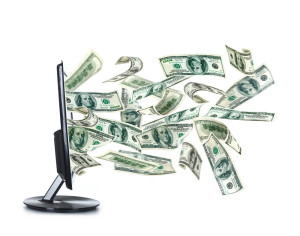This happened last year, too, about this same time of year. The markets had been pretty silent for a few months, so the blog looked pretty boring. Then, disaster began to strike.
Well, have no fear! The Village Id-Vestor is here once more!
Allow me to give a recap of what's been going on in the financial world.
UK? Voted to exit the European Union. The UK Pound dropped significantly in value, and there are lots of people predicting the end of the UK as we know it (I don't believe a word of it, personally).
US Stock market? All time highs.
Bond market? All time borings. Except junk bonds--corporate bonds with high default (bankruptcy) risk.
Gold and silver markets? The precious metals bottomed at the end of 2015 and have since been on a massive tear since January! I'll talk more about this later.
Oil market? Bottomed at decades-long low of around $26.03 in February, and has since nearly doubled, and is now around $45.
And that's the gist of things. There is uncertainty around every corner, with plenty of ways to lose money, but we're steering clear of all of them. So, what are we doing now with our money?
2016 Gains So Far
Well, as I mentioned above about the stock market hitting all-time highs, it's been a terrific year so far, and it's looking to be the best I've ever had, despite many analysts in finance not seeing much room for more upward momentum in stocks. The funny thing is, my success has hardly anything to do with these all-time highs. I've avoided these areas, because there are better places to put your money.
As I've mentioned before, when I see nearly all people piling into one end of the investing spectrum, it's a sure sign to run the other way. This time's no different. It's reason enough to exercise cautious optimism about markets in the short term... but ensuring that long-term, we're staying vested and not missing out on any huge upswings.
Because as we all know (or, as John Maynard Keynes put it), “The market can stay irrational longer than you can stay solvent.” In other words, things can seem like they're crazy, and we end up wanting to avoid crazy for the most part, but crazy can go on for far longer than we often think, and in the process of avoiding crazy, we miss out on huge opportunities.
This is one of the only pieces of wisdom I ever recommend you take from Mr. Keynes. And it's HUGE.
For the past several months, I've been in and out of many industries, locking in gains and banking as much coin as possible, while keeping my downside risk (risk of loss) to a minimum.
Keeping risk low involves investing in market bellweathers. I've done very well this year so far by gaining in solid companies like Cisco systems (4.7% in 37 days), Intel (2.3% in 28 days), and Whole Foods (.8% in 8 days--with much more on the way).
More speculative opportunities in other industries such as fertilizer (yum!), airlines, and tech, have produced gains of 2.4% in 30 days on Potash Corp, 7% in 6 days on JO, a coffee ETF, .6% in one day on Delta Airlines, and 3% in 38 days on Corning Glass--the company which makes the supposedly unbreakable glass for your smartphone (incidentally, my wife just broke the screen on her high-end cell phone a couple weeks ago, for what it's worth).
And lastly... making up the bulk of my gains so far this year, I've been speculating heavily in gold miners.
As I mentioned above, companies mining gold for business have had a tremendous bull market this year, and the average miner is showing gains over 80% since the market took off in February. Here's a cute little graph showing the change in value of this market index:
If you want to invest in a sector like this, but don't like the idea of taking the risk of putting money into individual companies, you can stick to the Market Vectors Gold Miners Index, which has ticker symbol GDX. Its chart is above. I've had six plays since January this year, netting about 9% over 120 days in shares of this ETF and its related call and put options.
I've also taken and closed several positions in individual companies. We earned 11% in thirty days on Silver Wheaton Corp, one of the stronger players in the precious metals mining industry. This is combined equity gains in addition to some call option premia.
As for a few miscellaneous precious metals miners, we earned 4.5% on Seabridge Gold in 22 days, 3.8% on Barrick Gold in 35 days, and 10.1% on Coeur Mining in 10 days.
Of course, there have been some losers along the way which have cut into my gains. I bought two VXX call options in April and March, which both expired worthless for a 100% loss, and sold two put options at a loss in April and Pay for 9% and 67% respective losses. Overall, these at into my gains my about $340, or 15%. However, I did book a gain of 49% on a VXX put option bought in June.
So far this year, the Village's overall portfolio percentage gain is sitting at 37%. If we can continue to replicate these gains throughout the rest of the year (why couldn't we?), we'll see annual gains this year close to 75% of our investable cash.
If you can remember, we booked annualized gains of about 16.39% last year. The quadruple those gains this year by keeping a solid asset base in safe investments, while also branching out into more speculative and lucrative investments, makes perfect sense right now.
Where am I headed now to invest?
That's simple. I go nowhere. I stick to the same simple strategy, in the same low-risk, high-reward sectors, with some minor adjustments.
First, I'll keep sticking with large caps stocks. There are plenty out there I'd like to own, but not at prices reflective of all-time market highs. I will probably end up selling puts on the shares I would be willing to own of some world-dominating businesses.
The reason I want to stick with this strategy is simple. My investing strategy doesn't include "swinging for the fences" or betting on huge gains in a short period of time. When it happens, that's great, but I don't ever count on it happening. My target is to increase my wealth by 1.5% every month, which will allow my money to compound enough for me to 100% quit my day job by the time my 40th birthday rolls around... which is quite a bit down the road.
As you can see, my conservative strategies are allowing me so far to beat that 1.5% per month requirement hand over fist. Six months into the year, and we're already up 37%.
How do I plan to hit that 18% per year to meet my investment objectives? I have spoken about this repeatedly on this blog, but I'll say it again.
I earn this income month after month by selling put options on stocks I'd like to own, and getting the premium for the option (have to pick the right stock at the right price of course), or by buying 100 shares of a company's stock, and selling a call option on the shares to get the premium.
The put option method is useful, because I can get high return with a low amount of capital. The bad thing about selling put options is leverage. If things move against me in a big way, I'll have to deposit a ton of money in my account to cover the stocks I end up having to own. For that reason, I keep things low-key in the put option department.
Rather, I prefer the second method. When I use the call option method, I guarantee myself the income from the option premium, I get any dividend paid over the period of ownership, and if the stock ends up going up in price, I also get paid capital gains.
Three ways to win. One is guaranteed. Two are likely. Three would be icing on the cake.
So, what else? I will be buying some smaller individual gold mining companies, this time without selling call options on the stocks, and plan to hold them through the end of the year at least.
The reason I'm going to forego the call options is to avoid the uncomfortable result of forfeiting potential gains. My small Village Portfolio would be up another 37% this year if I had simply held the stocks I mentioned above, instead of trying to get the guaranteed premium. The option forced me to sell the stocks at prices much lower than I could have sold them for, were it not for the obligation of the option.
Lastly... with any money I have left over, I'll likely study the charts on my Go-To list of stocks to see what is in buying range, where the volatility on these stocks is, and choose the best opportunities to buy shares and collect money selling call options.
If you don't know how to sell options on stocks you own, see what I've written on Short-Term Trading and Speculation elsewhere on this site.
How's Your Money Growing?
How are your investments? Are you learning all you can to make your money grow for you as quickly and efficiently as possible? If not, please take a look at the articles I've put out in the Investing section of the blog here. The worst thing you can do with your money is let it sit and do nothing for a long time. Your freedom is too important!
After all, the most important thing you can do with your money is learn to make it grow while you're sleeping.
Live long and invest,
Jeremiah
































